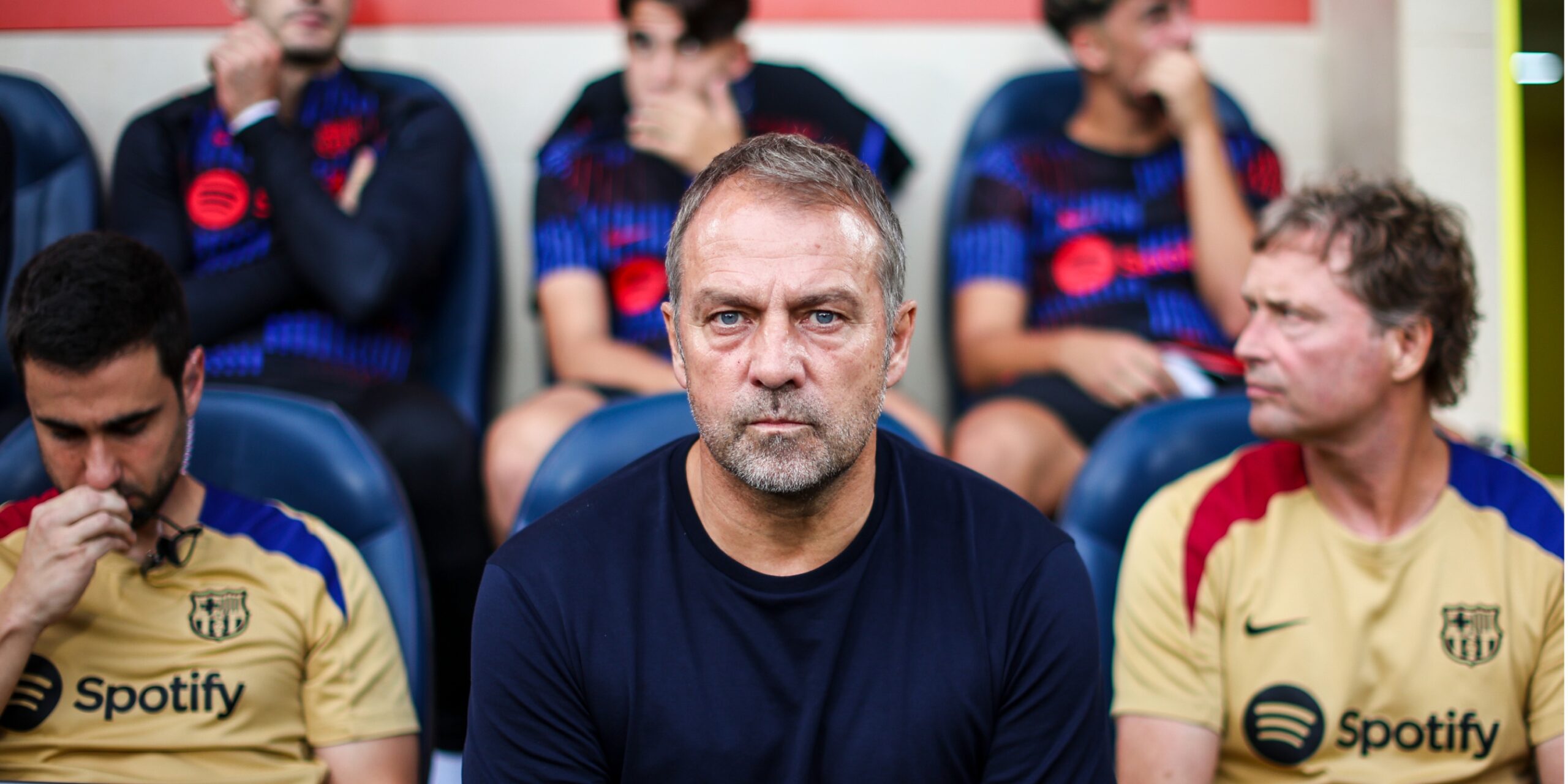Barcelona have won all six of their La Liga games in 2024-25 and are setting the pace in Spain. Hansi Flick’s arrival has helped them overshadow rivals Real Madrid, but can they keep it up?
The conservative estimate of Real Madrid‘s domestic dominance once Kylian Mbappé signed the dotted line on his contract with Florentino Pérez by his side was that they would win the next half dozen league titles at a stroll.
Then, depending on the push and pull of the transfer market, they could probably extend that into a decade of La Liga supremacy.
No matter what lens you were using to view it, the future was Merengue.
We’re just six games into the new league season and that particular future doesn’t look as certain as it once did. Madrid look devastating in attack, as we all presumed they would, but there’s a giant hole in their midfield that’s hard to reconcile with the talent in the squad. Toni Kroos is retired but his stature continues to grow. With every game that is played without him, it’s becoming increasingly evident how important he was to how Carlo Ancelotti’s team functions.
Meanwhile, Barcelona are playing like we haven’t seen in many years. There’s a vibrancy to every one of their attacks that’s been absent since Lionel Messi tormented opposition defenders. With La Masia players playing significant minutes and having real influence, it feels like anything is possible.
Their decimation of top-four hopefuls Villarreal at the Estadio de la Ceràmica on Sunday was further proof that Barcelona are a team on the rise. And it’s all down to one man.
Hans-Dieter Flick. The man who is here to put the final nail in tiki-taka’s coffin.
Fütbal with an umlaut has reached Barcelona. The era of Flicki-Flacka has arrived.
Before getting into how Flick has Barcelona playing, it’s important to understand the context of how they have started this season. Mired in a worsening injury crisis, they only signed one player in the summer – Dani Olmo from RB Leipzig. They also said goodbye to Ilkay Gündoğan and Sergi Roberto along with some bit-part players from previous seasons.
Ronald Araújo, Andreas Christensen, Marc Bernal, Fermín Lopez and Olmo have suffered injuries just before or during the season and have all missed time, some significantly more than others. Gavi is still on the mend from an ACL tear but should be back soon and Frenkie de Jong is still recovering from the ankle injury that saw him miss Euro 2024 with the Netherlands. One outstanding issue that needs addressing is Marc-André ter Stegen’s absence. He tore his patella tendon against Villarreal and will likely miss the rest of the season – but more on that later.
Barcelona’s squad is too threadbare to be this good, this soon. So, how have they done it?
Put Them Under Pressure
We’ll start at the front, shall we?
Barcelona have recorded 8.7 high turnovers (winning the ball within 40m of the opposition’s goal line) per game this season through six matches. That’s slightly higher than their average last term of 8.3 per game in 38 matches. But they already have two goals in 2024-25 from those high turnovers; they only had five from such situations across the whole 2023-24 league campaign.
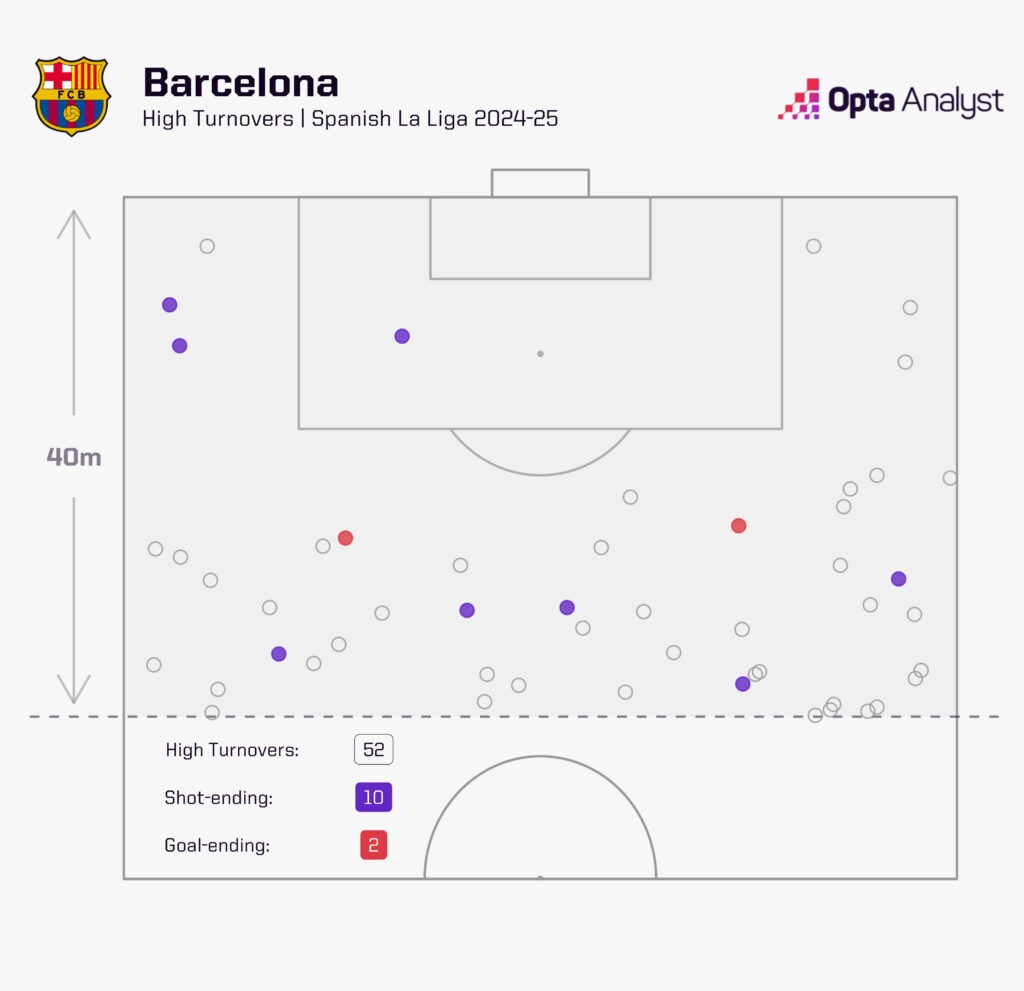
Barcelona are now a team that apply significant and very successful pressure on the opponent.
Lamine Yamal has seven tackles in the attacking third, more than any other player in La Liga this season. He has won possession back from opponents in the final third nine times, with only Pepelu from Valencia recording more among Europe’s top five leagues. Raphinha leads the team in possession regains (27) and the reason why both Yamal and his Brazilian teammate have been so successful is Flick’s use of his attackers when pressing.
Gone are the days of disjointed pressing structures and half-hearted individual efforts. It’s collective, collaborative and effective. Below, we see how Flick has Robert Lewandowski sitting back on the defensive midfielder with Raphinha and Yamal both ready to jump the short option. Their ability to close space quickly makes playing it short basically impossible.
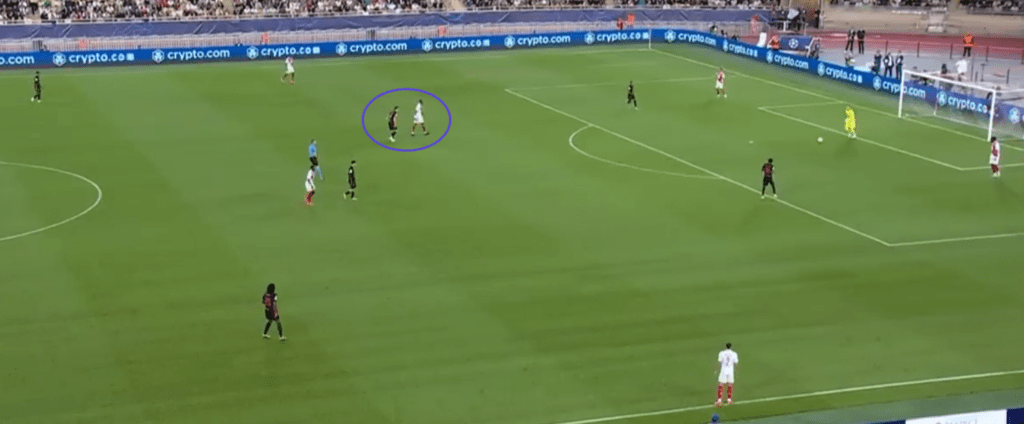
We saw something similar against Villarreal with slight variations depending on the phase of play. Lewandowski leads the line in terms of goalscoring but he isn’t the leading striker when it comes to defensive output, and everyone is better off for it.
Pivoting Away From A Single Defensive Midfielder
Aside from the obvious advantages of winning the ball back close to goal, it also eases pressure on the defence in transition. Teams prefer to go long than try to play through Barcelona’s increasingly vigilant attackers out of possession.
Amid all the injury news, there has been one very positive advance on that front and it has helped Barcelona both when they have the ball and when they don’t.
Pedri is fit and he is flying. You wonder what previous managers might have done differently if they had him available. Not since his second season with Barcelona in 2020-21 has he played more than 30 league games. He has started only 10, 22 and 16 La Liga games in his last three campaigns – that’s just 42% of possible top-flight matches. He has already started five of their six games this season.
He has won possession back from the opposition 26 times, just one fewer than Raphinha, but his presence basically everywhere in midfield and attacking midfield has transformed Barcelona. Jürgen Klopp famously said “no playmaker in the world can be as good as a good counter-pressing situation” but having Pedri applying a counter-press is another dimension of creativity altogether.
And that’s not the only area of the field where he has an influence.
There was much analysis of Xavi’s tenure at the club, why it didn’t work, and what needed to change. A large portion of time was spent debating the defensive midfield position – a vigorous and passionate but unproductive debate. Until they could get a Busquets clone, the whole enterprise was considered futile.
Rumours of Martín Zubimendi and Amadou Onana wound their way to dead ends. Oriol Romeu came and then left again after he looked unsuited to the role. Christensen was brought up from defence to fill the hole temporarily; Bernal was promoted from Barcelona Atlètic and looked immense before a cruciate knee ligament injury took his season away from him. Marc Casadó has stepped in there and Eric García more recently.
To be clear, Flick has no solution to the problem either, but what he has done is change the question we were all asking. Instead of who can play there, it’s a matter of who can support the player there and how can he lessen the burden in the Busquets role.
High pressure leading to fewer defensive transitions is a start. And then there’s Pedri, who drops into deep midfield to orchestrate play and take attention away from whoever happens to be playing there on any given day.
Against Girona, we saw Pau Cubarsí chipping in too, stepping up to play in the double pivot alongside Casadó. Playing Jules Koundé at right-back, a position he has grown into, means he can take a few steps inside and play as a centre-back. Yamal offers the protection necessary down the right to defend transitions when Koundé does have to step inside.
But who replaces Pedri when he drops into midfield, you ask? Raphinha drifts inside, combining with Olmo in the number 10 role as Alejandro Balde keeps the width on the left. Barcelona are never left with a technical deficit in build-up and are never left short-handed up front. The combination of Raphinha’s speed over the top and Olmo’s resourcefulness in tight spaces between the lines gives opposing managers a foreboding sense of doom. You can see it before it happens but there’s nothing you can do to stop it.
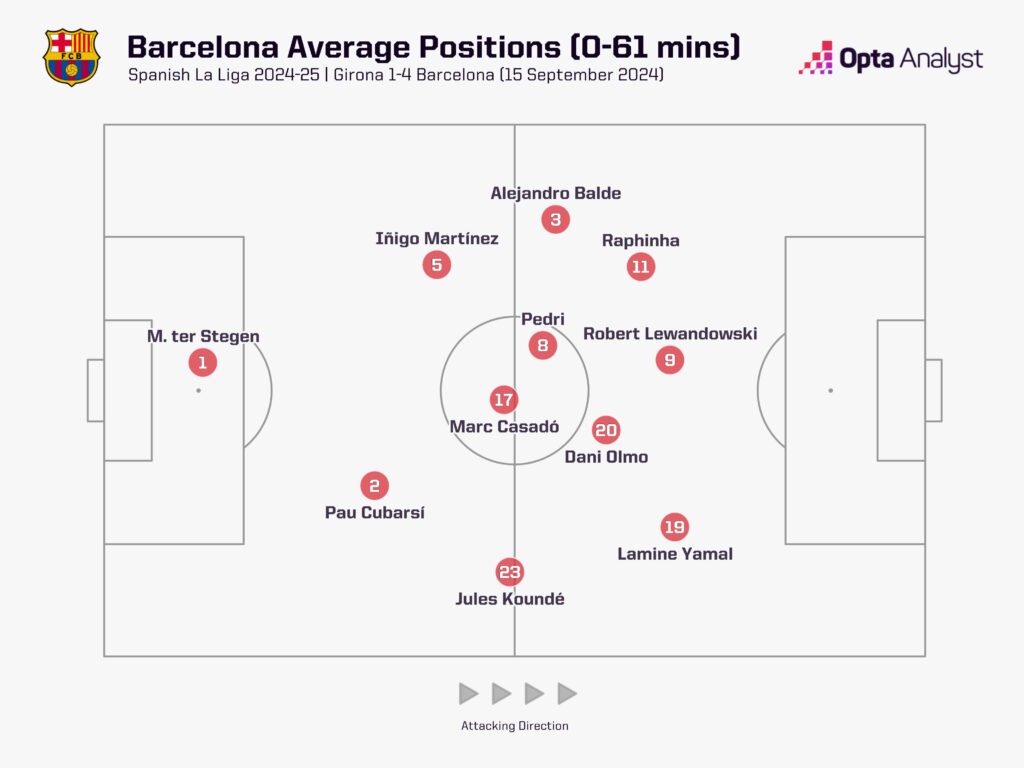
And that’s before we even really mention Yamal, arguably the most in-form player in the world. The 17-year-old has three goals and five assists this term, which is two goals shy of his La Liga total last season and the same amount of assists. He will almost certainly better every metric before he turns 18 next July.
Lewandowski, meanwhile, looks revitalised under Flick, his former Bayern Munich manager.
The Pole has six goals in 2024-25, averaging 1.08 per 90 – up from 0.62 in 2023-24 and 0.73 in his first season at Barcelona. He’s also having his best season for non-penalty expected goals per 90 (0.97), nearly double his average last term (0.49).
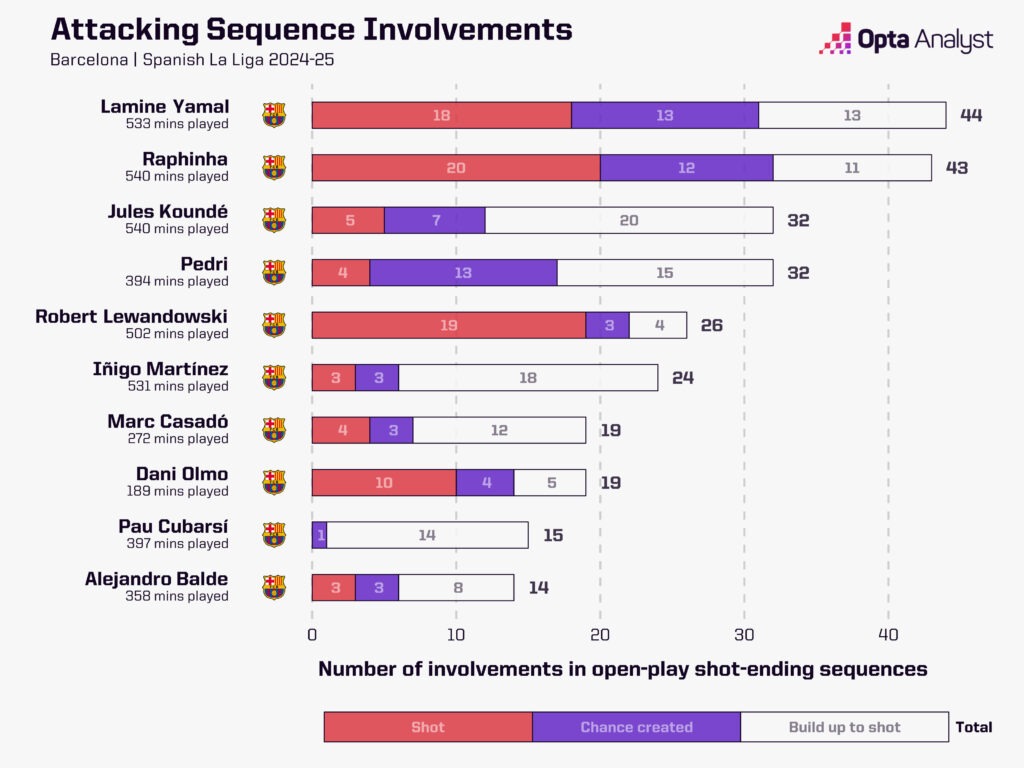
But this is the beauty of Flick’s Barcelona; there’s harmony to how they play, a cascading series of responsibilities that mean they are never short-handed when defending and always in or very close to a position of superiority on the ball.
Follow Lewandowski as he drops down a line to receive the ball and Raphinha will feast on long balls over the top. Solve that problem by clogging the middle and Yamal will devour his man on the right. Tilt the field to the right and Olmo will have a field day with his late runs into the penalty area and his exhaustive search for space where seemingly no space exists.
Sit back and clog up all of those spaces? Congratulations. You’re a shrivelled mess of bodies in your own penalty area just praying for the final whistle.
Keepin’ The Blues At Bay
It hasn’t been all sunshine and positive xG numbers in Barcelona since the start of the season. Barcelona fans still have a lot of anger and they have to direct it somewhere after all.
Most of it has been aimed in the direction of goalkeeper Ter Stegen. He was pointed to as the reason they lost to Monaco in the Champions League on Matchday 1 after a pass that left García in a seriously tight spot and which saw him sent off for a last-man tackle with just 10 minutes played.
Ter Stegen has conceded more goals than his expected goals on target faced (xGOT) value suggests the ‘average’ goalkeeper would have, and his passing, once considered a strength, has been coming under increasing scrutiny.
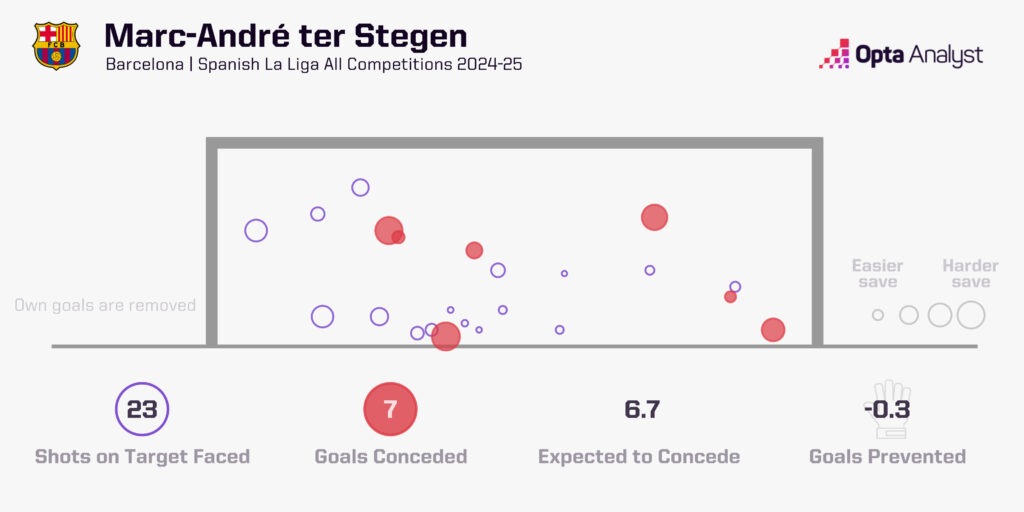
That problem has solved itself to some extent with Ter Stegen suffering a complete tear to his patellar tendon. The expected recovery time is around eight months, but he’s 32 now and on the decline so Barcelona are going to have to find a solution now both for the short-term and the long-term.
Aside from the big-name players making big-time plays, one of the most pleasing aspects of Barcelona’s early form is their reliance on La Masia. From day one, Flick has gushed over the talent flooding out the gates of the old farmhouse.
He has not been shy to use that talent either. Just three players used this season in La Liga are over 27. Gavi, who is still only 20, will come back and play a significant role soon, too. He will thrive in Flick’s aggressive counter-pressing style.
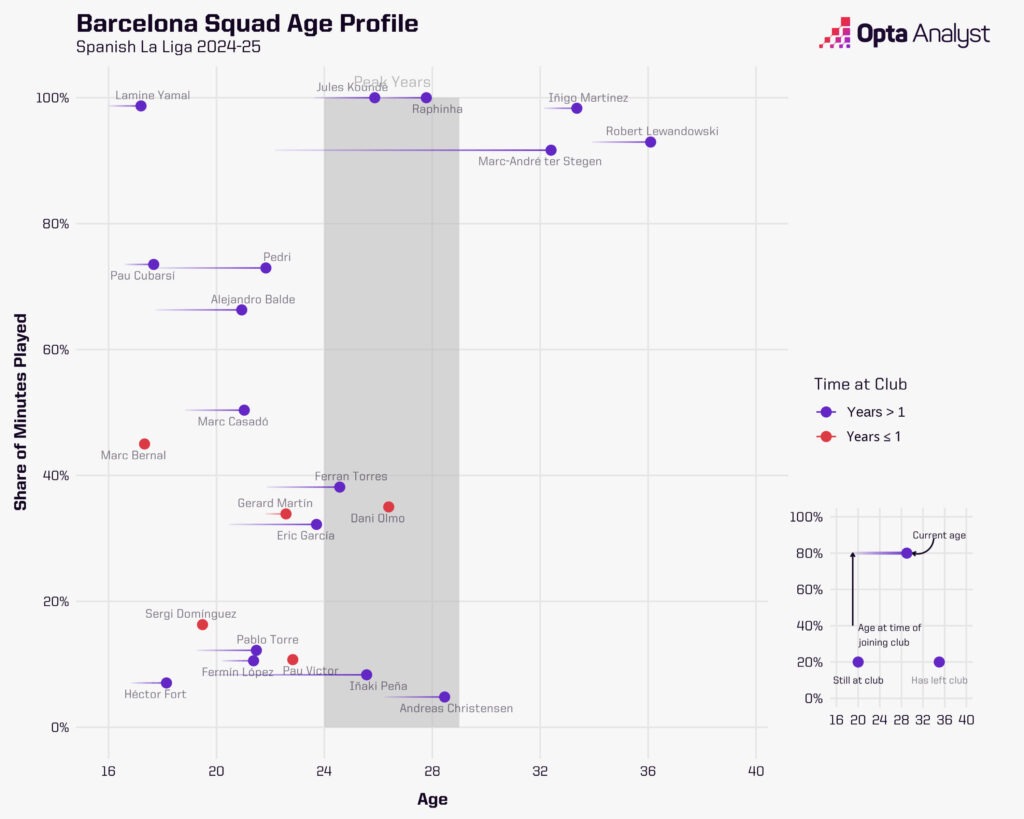
Johan Cruyff’s philosophy of Salidr y disfrutad (go out there and enjoy yourself) might now be delivered with a German accent, but that’s how Flick has Barcelona playing. There’s more freedom to their movement, more involvement between players, a sharing of responsibility and a greater sense of both possibility for them and sense of futility for their opponents.
We might only be 16% of the way through 2024-25, but the signs are good. They have scored 21 non-penalty goals in six league games under Flick; that’s the most by any La Liga team during the first six games since 2013-14 when Barcelona did the same.
That team went on to win the Champions League a year later. Barcelona shouldn’t be getting that far ahead of themselves yet, but it feels closer now than it has in a very long time.

Enjoy this? Subscribe to our football newsletter to receive exclusive weekly content. You should also follow our social accounts over on X, Instagram, TikTok and Facebook.
